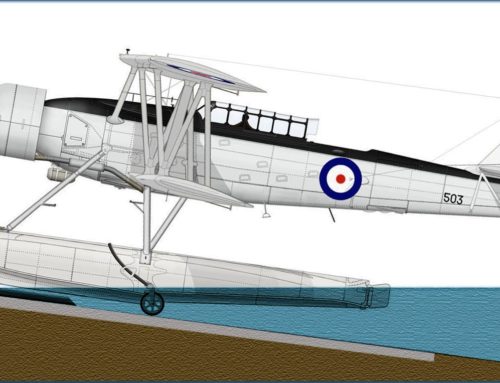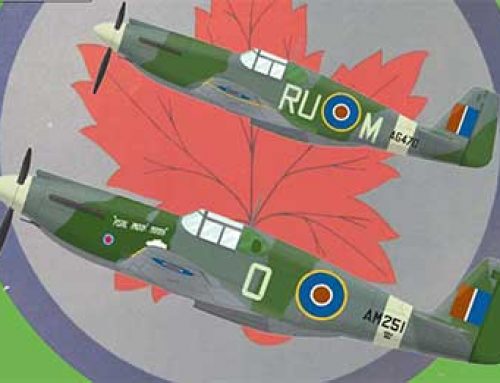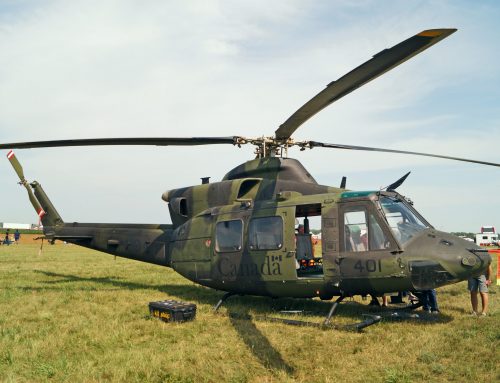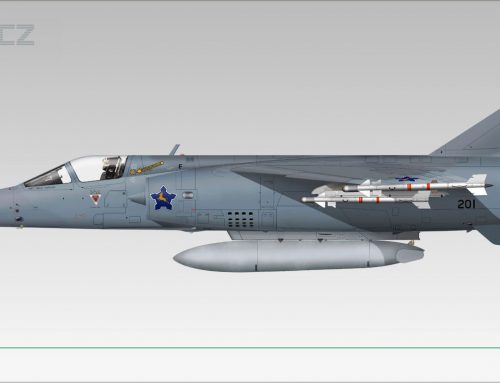AFV modeller with Spitfire question
Sat Jul 26 22:19:43 2003
OK, I normally build armour kits, but for a change of pace I’ve decided to build a 1/48 Tamiya Spitfire Mk.I, but just to be awkward I’d like to build it as a Mk.II, so what changes if any do i need to make?
Boogie Boy
Spit Mk II
Sat Jul 26 22:32:18 2003
The Mark II Spitfire was nearly identical to the Mk.I, but used a different prop/spinner and had a small bulge on the right side of the cowling for the Coffman starter. Both of these details can be had from Ultracast (#48113)(www.ultracast.ca), as well as other, nice goodies such as wheels and exhausts.
Joe Reder
Spitfire Mk.II
Sat Jul 26 23:42:31 2003
Here is what my little reference has to say on the subject Cameron. “The Spitfire Mk.II (Type 329) was basically a MK I built exclusively at Castle Bromwich and powered by a 1,175 HP Merlin XII (fitted with Coffman starter and running on 100 octane fuel) driving a Jablo Rotol three-blade constant speed airscrew. It incorporated Mk.I refinements from initial production in the first half of 1940 and whereas the Mk.I had armor plating added in service, the Mk.II had it installed on production.” This is from the old profile publications number 41 on the Spit.
The Modeller
Aside from all this good advice…
Sun Jul 27 09:34:38 2003
…don’t forget that there ought to be an armoured plate behind the pilots seat as well as an armoured headrest in a Mk.II, you’ll also commonly see the “appliqu̩” alloy armour plate over the fuel tank ahead of the cockpit.
The Tamiya Mk.I doesn’t include the pilot’s armour at all and don’t forget to trim back the protruding gun muzzles from the wing, a very early feature dispensed with long before the Mk.II came into service.
Edgar Brooks
Spitfire II
Sun Jul 27 02:15:52 2003
Early Mk.II Spitfires were identical to the Mk.I, except for the small Coffmann starter bulge, but later aircraft also had the larger oil cooler intake which everyone associates with the Mk.V.
Steve Sauve
I don’t that oil cooler remark is correct
Sun Jul 27 07:33:10 2003
And if it is, that’d be news to many of us. Can you cite any references for that?
Edgar Brooks
Spitfire II
Sun Jul 27 10:05:23 2003
The first indication I had was contained in the Mitchell Memorial Symposium, organized by the Southampton Branch of the Royal Aeronautical Society, in 1976, on the Spitfire’s 40th anniversary. In the notes, from originals by Joe Smith, it states that the oil cooler area, for the Mk.II, increased from .2 square feet, as in the Mk.I, to .35 square feet, exactly the same as the Mk.V. Also, on page 107 of “Spitfire, the History,” there is a picture of a Mk.II, used for LOX trials, in 1942, with the larger oil cooler clearly visible underneath. Don’t get the idea that I’m saying all Mk.II Spitfires were like this, in fact I doubt if the first were anything but identical to the Mk.I, since they were built from kits supplied by Southampton.
Steve Sauve
Interesting…
Sun Jul 27 10:40:59 2003
Do we know of any photos of operational Mk.IIs with the larger Mk.V oil cooler? By 1942 the Mk.II would be an ‘also-ran’, compared to the front-line Mk.V and Mk.IX; maybe this LOX Mk.II was just a test aircraft, not necessarily representational of the working fleet?
Alternatively, I’m wondering if this larger oil cooler was retro-fitted to the older Mark aircraft with the smaller Merlins, to maybe have a simpler supply system, since extra oil cooling would not be a bad thing?
This is interesting stuff, but I don’t think I’ve ever seen anything but a Merlin 45 (etc.) aircraft with the larger oil cooler.
Derek Pennington
My “History” shows that pic on page 107
Sun Jul 27 10:48:38 2003
Also on the same page, there is mention of fitting a Mk.III oil cooler. Could this be the oil cooler fitted to the Mk.III Spitfire? Reading it seems to imply that it was fitted as standard to Mk.II Spits…
Edgar Brooks
Spitfire II
Sun Jul 27 15:15:41 2003
The only clue, that I can find, also comes in “Spitfire, the History,” where a mod, to fit the oil cooler Mk.III, is stated to have been instituted 11-4-41 (remember, over here, that means April!) Whether this was the new size oil cooler I have not been able to ascertain, but it was certainly important enough to rate a mention. I also have a copy of the Air Publication for the Spitfire V, and cannot find any mention, in the list of mods to the Mk.V, of a change to a larger oil cooler. It is very difficult to find any photos of operational Mk.II Spitfires, especially those built after April 1941, but I doubt that a Mk.II would have been taken off the production line, and fitted with Mark V wings, solely to carry out engine tests. Also, I find it hard to believe, with Mk.II and Mk.V aircraft being produced at the same time, on the same production line, that a mod to one Mark would not have been incorporated in the other.
Edgar Brooks
Spitfires
Sun Jul 27 15:37:25 2003
I really must learn to read all of my messages before replying! The Mk.III was a totally unique variant, fitted, originally, with the Mk. XX Merlin, as fitted to the Hurricane II, and, as with the Hurricane, it was 4 inches longer (takes some finding, does that information!) Since the Merlin 45 installation was so successful, this was not continued. Incidentally everyone continually states that the Merlin 45 was identical to the Merlin III, in length; it wasn’t, it was actually longer, but, due to some inspired fiddling with the mechanism on the carburettor (they turned it through 180 degrees,) they were able to fit it into the same space. It is impossible to spot in photographs, but the carburettor intake, on the Mark V, is2-3 inches further back than on the Mk.I.
Regarding the oil cooler, according to the Symposium notes the frontal area was identical in the II, III, IV, V, VI, XII, Seafire I, II, III, and the part number, for the Seafires, was S.799-3C-528, for what that’s worth, but the number 3 appears again.
Steve Sauve
Re: Spitfire II
Sun Jul 27 15:43:05 2003
I suppose the trick now is to figure what the Mk.III cooler looked like, and that’ll solve the riddle.
Wasn’t the whole deal with the need for a larger oil cooler solely generated by going to the higher horsepower Merlin engines in the Mk.V? I don’t think that wings from a Mk.V would necessarily mean changing oil coolers – they and the aerodynamic outer cover must have been completely removable from the wing proper.
Graham Boak
Sorry Edgar, no
Mon Jul 28 03:56:13 2003
If anyone was using a “spare” Spitfire for engine trials, then uprating the oil cooler would have been part of the preparation for those trials. There’d be no point in doing a trial knowing that the cooling system wasn’t going to be up to the job.
Also, the Mk.II and Mk.V (a and b) have the same wing, so it wouldn’t need to be changed, just the new cooler fitted and perhaps some wider piping. No big deal.
I don’t know of any reason why the Mk.II production should have been altered to improve the engine cooling, especially as the Mk.II was being built at Castle Bromwich on highly standardised lines. Any change would be expected to be introduced at Supermarine first, so would be visible on late Mk.Is, too. Whereas there is a very clear reason why the Mk.V needed a larger cooler. None of these rule out it being true, but it does make it unlikely.
You do need rather more than one photo of a trials Spitfire to justify the comment.
Edgar Brooks
Spitfire II
Mon Jul 28 07:31:10 2003
I’m not saying that the change was due to the Merlin in the Spitfire II, just that it would make no sense to stock a different oil cooler, for the Merlin on the Spitfire II, when the Spitfire V is coming off the production line, at the same time, with the same wings, and it seems strange that a new oil cooler is slated as being introduced on the Spitfire II, just as the first Spitfire V comes off the production line. The big problem, of course, is that the introduction of the Spitfire V relegated the Mk.II to obsolescence, and, almost certainly, a training role, hence no photos of service Mk.IIs with a different oil cooler. Remember, too, that Castle Bromwich had their own test staff, with the likes of Alec Henshaw, who would have been trusted with any mods required. Funnily enough the photo on page 95 of Westland-built Mk.I AR238, in “Spitfire, the History,” appears to have the larger oil cooler fairing.
Graham Boak
That would depend upon pre-orders
Mon Jul 28 09:27:11 2003
I don’t rule out your suggestion, but remember that they are still stocking the old Merlin for the Mk.II, so all the auxiliaries will still be the same too. If you have an order for 500 (say) Mk.IIs, then your supplier has a contract to provide 500 early coolers, and unless there was a real need then you will fit 500 Mk.II aircraft with the early cooler.
I’m pretty sure that the batch size, within the main production run, was smaller than 500, but the principle still applies. Of course, the lead time for a change of production for the Merlin would be greater than that for the oil cooler. Perhaps the question that needs to be answered is just how many Mk.IIs were made in parallel with the Mk.V before the complete change-over? (Presumably STH will tell us that.)
However, once the aircraft gets into service, and used, then spares for the old cooler will run out and they will be fitted with the new one anyway. So the date of any photograph would need to be known. The late Mk.II/early Mk.V production fell into the period of presentation names, so possibly thatis a source of information of these types as they came off the line. But a photo showing the name is unlikely to show the oil cooler!
Steve Sauve
Interesting! Now I can buy into this as
Tue Jul 29 15:34:38 2003
A late modification of older airplanes, but if those are C1 roundels under the wings, then that would just about confirm that this is a really late war shot. Since AR238 was Stuck Off Charge in Jan 45, this photo must have been taken at the very end of its career (unless someone really ‘pooched’ the roundel painting instructions at an earlier time). Can anyone date this photo?
Nevertheless, I think you’ve shown me that this did happen to Mk.Is and Mk.IIs. Thanks for helping with this great thread!
Graham Boak
AR238 is a pretty late Mk.II
Wed Jul 30 03:57:30 2003
So the later oil cooler could have been on from the start. We need more pictures of similar aircraft early in their careers.
Steve Sauve
Agreed – the search is on! Smithers, release the hounds!
Wed Jul 30 05:07:21 2003
I’m going to keep my eyes open for further confirmations of this one.
Edgar Brooks
Early Spitfires
Wed Jul 30 15:40:39 2003
Didn’t want to say anything, until I was absolutely certain, but we have a Mk.I, AR213, based near here, which is exactly as it was when released at the end of the war. It has a Mk. V oil cooler, and the Battle of Britain Memorial Flight’s Mk. II, allegedly unrebuilt, also has the large oil cooler. That has to be a conversion, at some time, though, since it was the 14th Mk.II ever built.
Edgar Brooks
Spitfires
Wed Jul 30 16:03:45 2003
Sorry I couldn’t get a reply to you sooner; somehow I suspect that we’re actually of like mind. I don’t think that many modified Mk.IIs went to active Squadrons, but training Squadrons might well have received them, and it would not have been a difficult mod, just a new housing, since I think that it was only the frontal area that changed. Actually I begin to wonder how many photographs, allegedly of Mk.Vs, could have been of earlier Marks. How can you tell, if you can’t see the serial no., and it still has the earlier externally-armoured windscreen?
I take your point regarding the stock, but 100 aircraft would require far more than 100 oil coolers. There would need to be replacements for any possible damage, e.g. a wheels-up landing, + replacement for clogged, worn-out, cores. It would make far more sense to try to stock only one type for all Marks, wherever they were.
Incidentally, can you imagine how it felt to read the information, and realize its possible import, after all those years? It’s rather like finding out that your uncle is actually your father!
Steve Sauve
I think you’ve convinced us that some Mk.Is and IIs
Wed Jul 30 19:47:45 2003
Had the Mk.V oil cooler at some point, but I also think it’s safe to say that these aircraft were being used later in their lives in secondary roles (like training), when they were well past their prime as fighters.
I now believe that this modification was done on the early airplanes, but now I’d need to see photos of Mk.Is/IIs in front line service to really get behind this idea.
I sincerely look forward to finding or being shown photos that support this.
Graham Boak
Digging into The History
Thu Jul 31 06:50:03 2003
The big oil cooler appears on the High Speed Spitfire, and then on the Mk.III. It is specifically said to fit onto the same mountings and use the same piping, making the conversion simply a matter of having enough of them. In the list of modifications applied to the Mk.II is indeed the Mk.III oil cooler, April 1941. This was at about the same time as the first Mk.V – I didn’t bother counting just how many more MkIIs were to come, but about two pages worth of Pxxxx serials…
Incidentally, the AR series from Westland didn’t fly until July 1941, and switched over to Mk.V fairly early on.
So it seems quite likely that up to 100 or so Spitfire Mk.IIs COULD have been fitted with this from the start, and the 50 or so Westland ones probably were. However, we don’t know the status of the modification – presumably it was not a “must do to all, soonest” but “on manufacture” or “as convenient”?
Edgar Brooks
Spitfires
Thu Jul 31 13:48:52 2003
Graham, I think that you’re absolutely right; if the new oil cooler would fit the old wings, only requiring an easy-to-fit housing, why keep stocks of the old type, when Seafires, Mk.IV, V, VI, XII will all be using the new size?
(thanks to Brett Green for permission)





